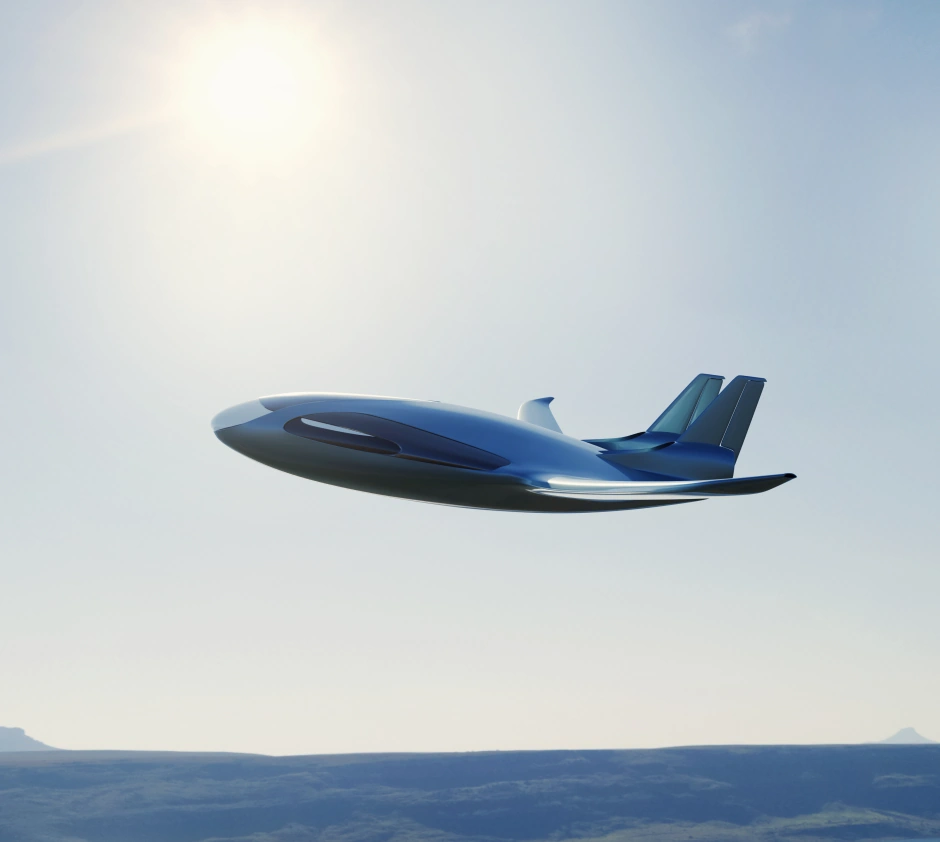Aviation is one of the most difficult sectors to decarbonize. Today’s tried-and-tested but energy-intensive airliners are propelled by combustion engines that run on fossil fuels. With the reduction of the carbon footprint of air transport becoming a priority, several technological solutions are being explored: hydrogen, synthetic fuels, and electric propulsion.
Concerned with the latter, the joint DISC-AER laboratory results from a cooperation between Mines Saint-Étienne and EENUEE, a start-up specializing in the development of electrically propelled regional airplanes. Its aim is to develop advanced technical solutions for a more energy-efficient aviation sector, relying in particular on new-generation composite materials.
A fast and energy-efficient alternative for interregional travel
One of the main challenges of electric aircraft lies in the capacity of batteries to store sufficient power to cover flights over long distances. For shorter trips, however, and for breakthrough aerodynamic designs that reduce energy requirements, this technology is becoming a viable and competitive alternative. This is the market segment targeted by EENUEE, the start-up which is developing new generation, electrically propelled regional airplanes. Its aim: to come up with a 19-seater model by 2031, designed for maximum autonomy on routes of 500 km.
Named GEN-ee, this aircraft aims to provide efficient regional links relying on the network of local airfields that are often underexploited. Its ability to take off and land over short distances means it could operate on these infrastructures, where the 600-meter runways are much shorter than the 1.5 to 2 km required for an Airbus A320. This prospect paves the way for more flexible, eco-friendly air travel, especially for latitudinal trips that are often long and restricted by existing infrastructures. In other words: “a collective air service making it possible to travel from Saint-Étienne to Bordeaux, for example, or from Nice to Grenoble in just 1½ hours, compared to 7 hours by train”, explains Sylvain Drapier, a professor at Mines Saint-Etienne and director of LabCom DISC-AER.
The use of water bodies as places to land when the terrain is hilly, a model based on hydrofoil craft – as profiled wings allow planes to land on water – is also under study. EENUEE’s founder, who has already designed a small two-seater plane capable of landing on water, snow and hard ground, has contributed this expertise to the project.
Aerodynamic design for better performance
One of the keys to this project’s success is the innovative design of the GEN-ee: a Blended Wing Body (BWB) fuselage, or lifting body. Unlike the classic ‘tube-and-wings’ design, BWB consists of a lenticular (lens-shaped) structure with no distinct junction between the fuselage – the central structure – and the wings. As a result, the fuselage actively provides approximately 50% of the lift, which improves aerodynamic performance and energy efficiency. “Compared to a conventional regional plane, this architecture can cut energy consumption by 40 to 50% and, associated with electric propulsion, reduces CO2 emissions by at least 90%”, explains Sylvain Drapier.
This BWB shape is rarely used in commercial aviation, mainly because it is easier to pressurize a tube-shaped fuselage. Indeed, classic aircraft must not only meet aerodynamic requirements, they must also withstand cabin pressure, hence the cylindrical shape which is optimal for this usage. But for a short-distance plane flying at low altitude (between 1,000 and 3,000 meters), there is simply no need for pressurization. Without this requirement, it therefore becomes possible to use more optimized aerodynamic shapes, reducing vapor trails and improving energy efficiency.
The lack of a pressurization system, assisted controls and many mobile parts, such as wing flaps, ailerons and tail units also makes the aircraft lighter and reduces its energy consumption. This simplified approach is coupled with a motorization which, in the current state of knowledge, is based on lithium-ion batteries comparable to those used in electric SUVs. “Two battery packs are enough to power the 250 m² of wetted area [surface exposed to air] of the GEN-ee over a distance of 500 km”, Sylvain Drapier adds. Most of the electrical power is required during take-off, as once in flight, thanks to the slender shape of the BWB, comparable to that of a glider, it takes only 20% of that power to keep the plane in the air.
Thermoplastic composites: ad hoc materials
While EENUEE deals with propulsion and onboard systems, Mines Saint-Étienne is co-leading and assisting EENUEE in the fuselage design and optimization, “so that it is holds together and flies”, sums up Sylvain Drapier. The researcher, who specializes in composite material mechanics, and his team already have an expert command of the manufacturing processes of high-performance structures. Their challenge lies above all in the optimization and design of the fuselage to guarantee its resistance to mechanical strain while maintaining maximum energy efficiency.
To achieve this, DISC-AER is counting on thermoplastic polymers, such as the Elium® resin developed by Arkema, which has a mechanical resistance and recyclability that set it apart. Unlike thermosetting polymers, which require firing at high temperature and under pressure, thermoplastics can be transformed at room temperature or in a chamber at 100°C, thus reducing their cost and energy consumption. Again, unlike thermosetting materials, which deteriorate with heat, thermoplastics retain partly reversible chemical bonds, making it easier to separate the fibers from the resin using high temperatures.
These properties make it possible to envisage advantageous assembly techniques, such as autogenous welding, which requires no additional materials. By using melted resin, for example, to make joins as it resolidifies, we would avoid the need for intrusive assembly methods such as riveting, for improved integration of the different modules. These properties also offer new maintenance prospects. “We are thinking about the possibility of dismantling certain parts by heating the structure locally, which would make repairs easier”, the researcher specifies. Lastly, by encouraging the partial recovery of fiber, these polymers pave the way for a more circular aviation, with the recycling of used fiber which could even be reused in the production of new aircraft.
From the concept to the first industrial demonstrators
Of course, work remains to be done before an operational model is achieved, and several phases of testing will need to be conducted. “EENUEE began with proof-of-concept projects at a 1:7 scale and is currently developing others at 1:4, before testing a full-scale demonstrator by 2029”, Sylvain Drapier predicts. This scale-up will make it possible to validate the performance of the materials, the stability of the structure and the overall energy efficiency of the aircraft.
For the time being, the Mines Saint-Étienne teams are testing the properties of the Arkema resin at room temperature, in order to assess its behavior during implemented processes such as liquid resin infusion. They are also studying the integration of an energy report on the entire production-exploitation-end-of-life-cycle chain. “We do not yet have an exhaustive vision on this issue, but with electric propulsion, low energy implementation and the use of reparable and recyclable materials and structures, we expect the final carbon footprint to be highly favorable”, adds the researcher. DISC-AER would therefore contribute to laying the foundations for a new generation of regional airplanes with low carbon impact.





